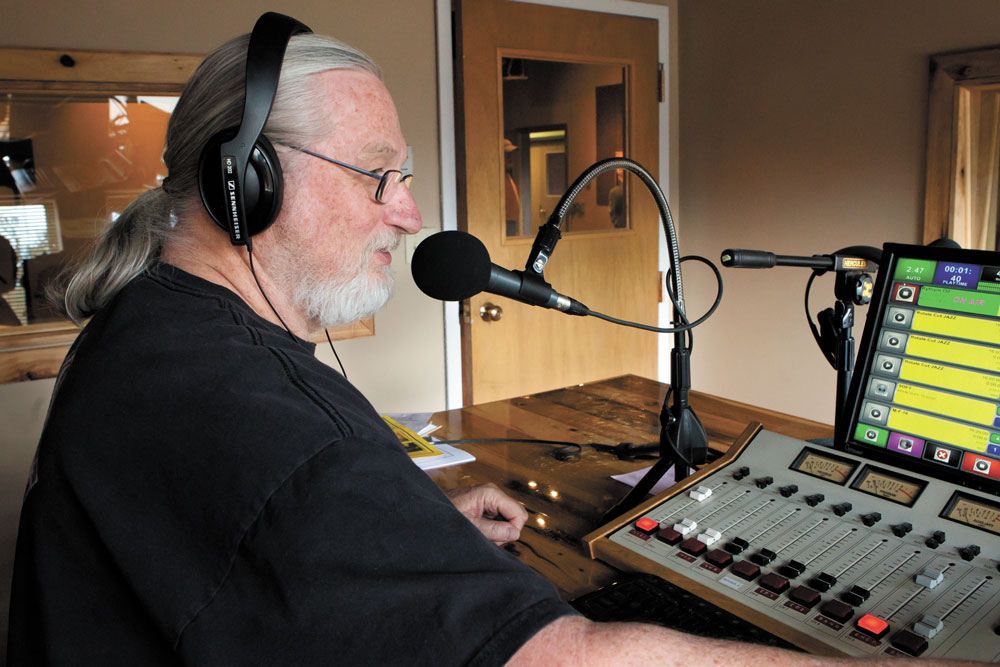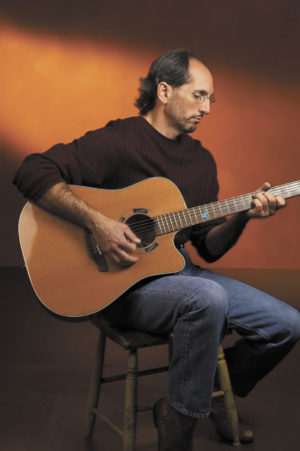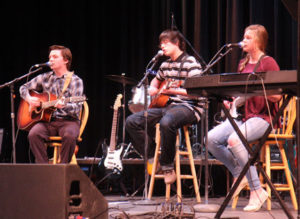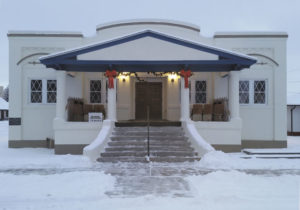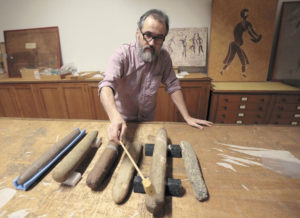
By Elliot Jackson
The Central Colorado region is rich in community radio – small public radio stations that cater to the musical tastes and talents of their listening areas. Some of them cover a wide listening area; others, like Salida’s KHEN, are LP (low power) stations that might cover only a few square miles. And at least one has made the transition from LP to full-power station: KLZR in the tiny town of Westcliffe (population 568, not including cows), formerly KWMV-LP. That a town this small has a community radio station that has not only survived since its inception in the early 2000s, but thrived as an all-volunteer station, is a testament to the vision and devotion of a handful of folks who were there at the beginning and continue to guide the station’s development.
The handful of folks include KLZR board members Joanie Liebman and Gary Taylor, station manager Bob Thomason and long-time DJ and correspondent Shanna Lewis. But it was Westcliffe businessman Lou Kravitz who got the ball rolling in 2001. According to Liebman, Kravitz took note of the Federal Communication Commission’s (FCC) decision to open up some LP licenses, and made the decision that “Westcliffe needs a community radio station.” He worked with Thomason and others to create the application. Instead of forming a separate 501(c)(3) (non-profit) organization to apply for the license, they decided to approach the Westcliffe Center for the Performing Arts, located in the town’s historic Jones Theater, to make the application on the group’s behalf. The WCPA agreed, and the group applied for the license in 2001. It was successful, and KWMV, as it was then known, built its broadcast studio in the southwest corner of the Jones Theater.“It was a hand-built radio station,” said Liebman and Taylor. “Community members installed the antenna and did all the tech work.” The license was granted in 2002 and the station began broadcasting in 2004. At first, it was a “robo-station” – there were no live DJs, and Thomason and others burned the music for an automated programming system.
There was little community support at first – the fledgling station’s first challenge, according to Liebman, was “to get people to listen.” The limitations of a low-power system made themselves felt – the signal only travelled within a radius of 15 miles or so. “People would tell us that they could listen to us in their cars, but not at their houses!” says station manager Thomason. So even in a tiny town, awareness beyond a small circle of listeners, devoted volunteers and fans remained limited.
Partly as an effort to raise community awareness, and partly as an effort to raise operating funds, KWMV started the High Peaks Music Festival in 2008. The festival, hosted at the Amphitheater performance space outside the Feed Store in downtown Westcliffe, features a mix of folk, singer/songwriter and Americana bands, and in its eighth year has become one of the station’s signature events.
[InContentAdTwo] Meanwhile, there were other community outreach programs that began to increase the station’s visibility in the community. In 2009 KWMV, in conjunction with the Custer County School District, began the Youth Radio Program for high school students to begin to learn aspects of broadcasting, including DJ’ing and interviewing. One of the programs, “Now and Then,” paired current Custer County High School students with former graduates who still lived in the area. The success of this collaboration with the School District earned goodwill, new listeners and more donations.
 The success was also leading to growing pains. The station, which had started as a subsidiary of the WCPA, was rapidly outgrowing its space in the Jones Theater. KWMV was actively engaged in fundraising for a new space – and had a new ambition: to transition KWMV-LP into a full-power radio station, which would require a new license from the FCC.
The success was also leading to growing pains. The station, which had started as a subsidiary of the WCPA, was rapidly outgrowing its space in the Jones Theater. KWMV was actively engaged in fundraising for a new space – and had a new ambition: to transition KWMV-LP into a full-power radio station, which would require a new license from the FCC.
There are only two ways to upgrade a radio signal from low-power to full-power: either wait for the FCC to announce a new application period for licenses, and hope that when that time comes your application is accepted; or to buy an existing station’s license. Either way, the process involves money, timing and a bit of luck. In 2013, while the Board, station manager Thomason, and the volunteers involved with the station were preparing to move the studio from the Jones Theater into a newly-renovated space on Second Street, the word came that the license for a local community commercial station, KLZR, originally a rock and roll station whose signal originated in Lawrence, Kansas, might be up for sale.
The KWMV community had to spring into action to take advantage of the situation, which involved a capital campaign not only to purchase the license, but also a new antenna and new equipment. In the end, the campaign raised $60,000, and KWMV not only had moved into a new station building, but was taking on a new identity: in 2014 it began broadcasting as KLZR.
Along the way, the station has evolved from its beginnings, with music programming that came almost entirely from a computer, to featuring 35 on-air DJs whose tastes reflect a broad and eclectic mix of styles, from punk rock to opera, with folk, jazz, blues and Celtic music in-between. There is also “Music Your Way,” billed on the KLZR schedule as “Local Deejays Play Their Favorites,” which is how many fledgling on-air personalities get their start. There is also locally-produced spoken-word and news programming: “Valley Views,” for example, which Liebman describes as “interviews with interesting and influential members of the community,” continues the talk-show tradition started by Thomason and Lewis, the original “on-air personalities” back in the early days of the station. While the Youth Radio Program no longer exists in its original form, young DJs are still learning on-air craft with the West Custer County Library’s own Jess Carter, who mentors the “Teen Takeover” program that airs the first Friday of every month. “The one thing a local station can do,” say Liebman and Taylor, “is be local.”
Adds Lewis, “Being a community radio volunteer has given me a peek into aspects of the radio world that I would’ve never seen otherwise, like the arcane workings of the FCC and the technology that gets our voices out over the air. It also gave me a chance to create new programming and help get other people on the air too.”
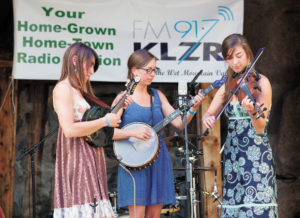 All in all, over 100 volunteers run every aspect of the station, from engineering to event coordination to fundraising, in addition to on-air programming. The major fundraisers for the station include the High Peaks Festival, “Taste of the Valley,” an invitation-only, sit-down dinner and wine-tasting, and the Community Spirit Campaign, in addition to memberships.
All in all, over 100 volunteers run every aspect of the station, from engineering to event coordination to fundraising, in addition to on-air programming. The major fundraisers for the station include the High Peaks Festival, “Taste of the Valley,” an invitation-only, sit-down dinner and wine-tasting, and the Community Spirit Campaign, in addition to memberships.
Plans for the future include an expansion of local news coverage, which seems very timely in connection to the station’s role in providing news and emergency conditions updates for the Westcliffe area’s Junkins and Hayden Pass Fires this past summer, and a new music festival, starting in 2017, called “Rock’n’Soul,” which will be held in June at the Painted View Ranch. In the meantime, between managing the spurt of new volunteers that escalated after the full-power transition, and a possibly new collaboration with the School District, KLZR-FM may just become the biggest little radio station in the central mountains. Check them out at 91.7 on the FM dial, or online at www.klzr.org.
Elliot Jackson lives in Westcliffe, and would like to thank Joanie Liebman, Gary Taylor, Steve Chandler, Bob Thomason, Paul Leach and Shanna Lewis for their time and input on this article. Anything false, meretricious, inaccurate, or just plain wrong is her fault alone.

